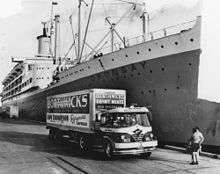SS Oronsay (1950)
- For other ships of the same name, see List of ships named Oronsay.
 SS Oronsay and a refrigerated meat truck at Brisbane | |
| History | |
|---|---|
| Name: | SS Oronsay |
| Owner: | 1951-1966 Orient Steam Navigation Company. 1966-1975 Peninsular & Oriental Steam Navigation Company |
| Operator: | 1951-1960, Orient Line. 1960-1966, P&O-Orient Lines. 1966-1975, P&O Line. |
| Port of registry: |
London, |
| Route: | Tilbury-Sydney via Suez |
| Builder: | Vickers-Armstrongs, Barrow-in-Furness |
| Cost: | £4,228,000 |
| Yard number: | 976 |
| Laid down: | 1949 |
| Launched: | 30 June 1950 |
| Sponsored by: | Mrs A. Anderson |
| Completed: | May 1951 |
| Maiden voyage: | 16 May 1951 |
| Out of service: | 28 September 1975 |
| Identification: |
|
| Fate: | Scrapped, 1975 |
| General characteristics [2] | |
| Type: | passenger liner |
| Tonnage: | |
| Length: | |
| Beam: | 93 ft 6 in (28.50 m) |
| Draught: | 31 ft (9.4 m) |
| Installed power: | 42,500shp |
| Propulsion: |
|
| Speed: | 22 knots (41 km/h; 25 mph) |
| Capacity: |
|
| Crew: | 622 |
SS Oronsay was the second Orient Line ship built after World War II. A sister ship to Orcades, she was named after one of many islands called Oronsay on the west coast of Scotland.[2]
The liner was completed in 1951 at Vickers-Armstrongs, Barrow-in-Furness; but several months behind schedule due to a serious fire while in the fitting-out berth. The Oronsay operated the UK to Australasia service, via the Suez Canal. Her accommodation set new standards, in both first and tourist class, with decor by Brian O'Rourke. On January 1st 1954, Oronsay left Sydney on the first Orient Line transpacific voyage to Auckland, Suva, Honolulu, Victoria, Vancouver and San Francisco, returning via the same ports. In later years the transpacific sailings became a regular feature of the Orient/P&O services. In 1960 the Orient Line and P&O fleets were merged under the control of P&O-Orient Lines (Passenger Services) Ltd. Oronsay continued to operate under the Orient houseflag and with her corn coloured hull until 1964, when her hull was painted P&O white. In 1966, P&O having acquired the balance of the Orient shares (it had controlled Orient since 1919), Orient Line was wound up and Oronsay, along with her fleet mates was transferred to the ownership of Peninsular and Oriental Steam Navigation Company and hoisted the P&O houseflag. Liner services were producing dwindling returns as jet airliner services between Europe and Australia expanded and Oronsay spent more and more time as a cruise ship, but, with declining passenger numbers, P&O could not sustain its large passenger fleet, withdrawals beginning in 1972. The large oil prices rise of 1973/4 were the final straw and Oronsay was withdrawn from service, the penultimate example of the six post war 28,000 ton types (Arcadia sailed on until 1979). On October 7th 1975 she arrived at Kaohsiung to be broken up by the Nan Feng Steel Enterprise Co. [3]
Popular Culture
Oronsay was one of the ships seen in the 1958 British comedy film The Captain's Table. Stock footage of all three post war Orient ships was used to depict the fictional SS Queen Adelaide and some scenes were shot on board at Tilbury Docks.[4] Orient ships were also seen in stock footage in the 1962 British comedy film Carry On Cruising.[2]
Famous passengers
- Tony Abbott, the 28th Prime Minister of Australia, aged two, emigrated to Australia with his family aboard the Oronsay in 1960.[5][6]
- British historical novelist Eleanor Hibbert travelled on the Oronsay from United Kingdom to Sydney in 1970.[7]
- Musician David Bowie travelled on the Oronsay from San Francisco to Yokohama in March/April 1973.[2]
- Michael Ondaatje's 2011 novel The Cat's Table is a fictionalised account of the author's childhood voyage in 1954 from Ceylon to Britain on board the Oronsay.
References
- 1 2 3 "ORONSAY". shipspotting.com. Retrieved 9 December 2012.
- 1 2 3 4 Goossens, Reuben. "SS Oronsay". ssmaritime.com. Retrieved 9 December 2012.
- ↑ Kludas, Great Passenger Ships of the World Vol.5
- ↑ Sinden, A Touch of the Memoirs
- ↑ "British migrants - Selection documents for free or assisted passage (Commonwealth nominees)". National Archives of Australia. Retrieved 10 September 2011.
NAA citation "NAA: A1877, 07/09/1960 ORONSAY ABBOTT R H". - ↑ http://naa12.naa.gov.au/SearchNRetrieve/Interface/DetailsReports/ItemDetail.aspx?Barcode=7328488
- ↑ "It Feels Like 'Coming Home': Mrs Eleanor Hibbert. English Author Would Like To Live Amongst Us". The Sydney Morning Herald. Mar 1, 1970. Retrieved April 18, 2014.